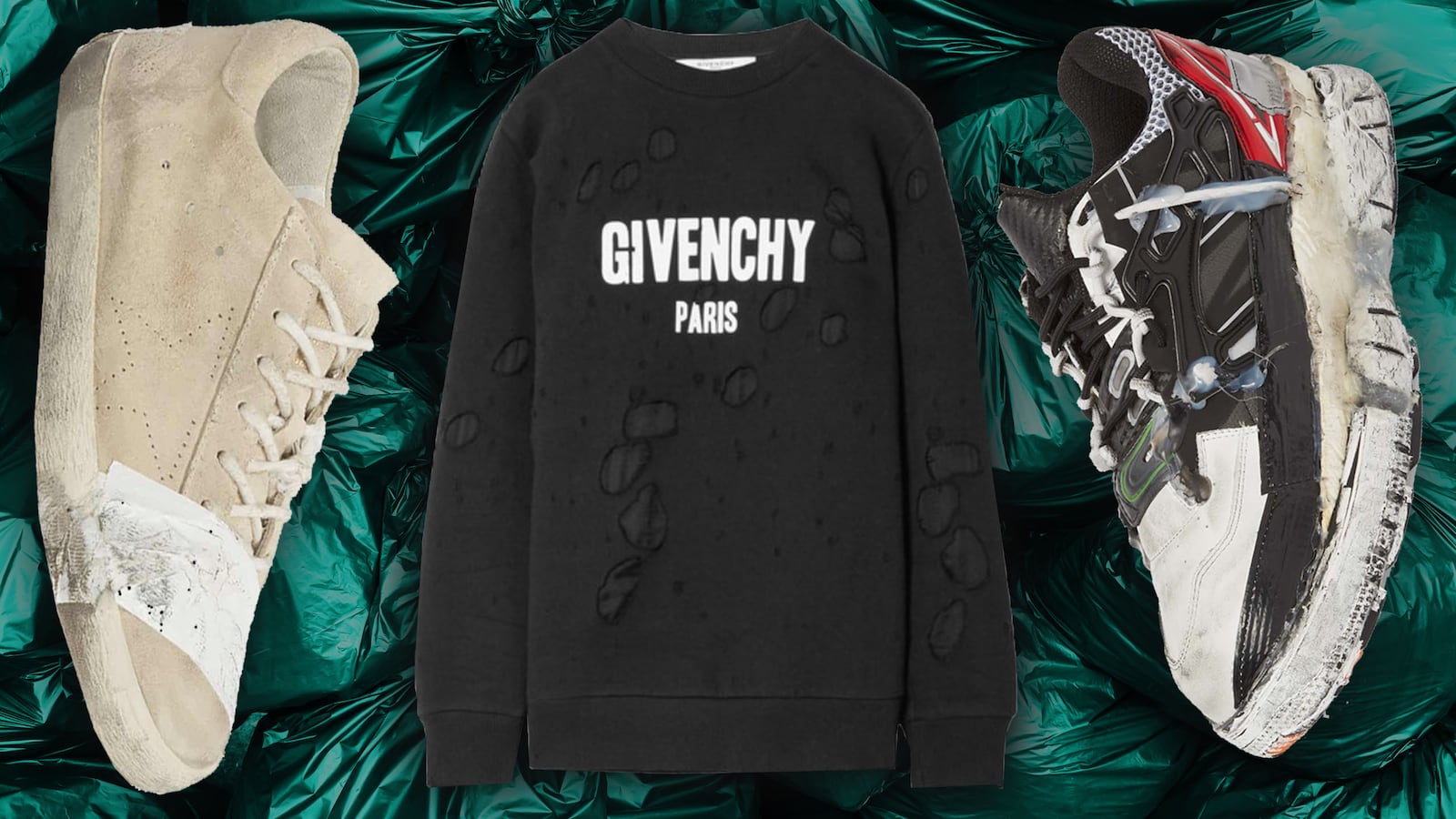There are some mysteries we may never solve. Is there intelligent life on Mars? What happens in the Bermuda Triangle?
And: Who buys $535 beat-up sneakers held together by duct tape?
That last question was bitterly posed last week on Twitter, when a screenshot of the “Superstar Taped Sneaker” by Italian designer Golden Goose went viral. The (now sold out) kicks were dirtied, tattered, and seemingly held together by adhesive.
In a viral tweet, comedian Christine Sydelko wrote, "there are people in the world wearing plastic bags as shoes because they can't afford any but these HIDEOUS things are selling for $500 the fashion industry is truly so fucking stupid." Others were quick to agree, accusing the line of appropriating poverty.
If this story sounds familiar, it’s because the same thing happened in 2016. After its "Distressed Superstar Sneakers" earned the internet's ire, Golden Goose stood by its design. Reps for the line told Us Weekly they were inspired by “West coast skater culture.” (Golden Goose did not respond to The Daily Beast's request for comment.)
Of course, Golden Goose is not the first, or last, line to profit off of undone, beat-up, or otherwise purposefully damaged clothing. Both high and low end labels churn out pieces that make their fan base look like they just fell down a garbage chute and lived to tell the tale.
Givenchy sells a ripped crewneck sweatshirt for $1,165. For just under a grand, you can scoop up a frayed red fisherman’s sweater from R13. If you’re on a budget, fast fashion retailer Pretty Little Thing has $35 “Bum Rip” high-waisted skinny jeans that are just a few strategically-placed threads away from being assless.
While denim especially seems to have lost its mind of late (see: the tragedy that is Nordstrom’s “muddy jeans”), distressing is nothing new.
“It began as an anti-fashion stance of the late ’60s and early ’70s,” Nancy B. Diehl, director of NYU’s Costume Studies program, told The Daily Beast. “Those marks of wear make clothing really individualized, and the idea is that has more authenticity.” In pursuit of a worn aesthetic, hippies would sandpaper Levis down by hand.
Even if baby boomers weren't trying to make a statement with their dungarees, home economics classes taught them basic sewing skills that allowed them to patch up hand-me-downs. This mending was more of a pass at frugality rather than a radical statement, but the vogue for worn and vintage took hold.
Somewhere along the line, Diehl said that make-do mentality permeated into "fashion fashion."
Japanese designers Rei Kawakubo (of Comme des Garçons fame) and Yohji Yamamoto garnered attention with silhouettes that resembled Swiss cheese. Later, Belgian designers such as Martin Margiela and Ann Demeulemeester followed suit. Margiela's $1,645 "Fusion" sneakers have faced backlash near Golden Goose-proportions.
In the 1980s, movies like Withnail and I popularized a pre-Grunge aesthetic of entitled youth rolling around in secondhand Crombie-style overcoats, grandpa shirts, and long, woolly scarves. The downtown New York look of the 1980s, made mass-market visible by Madonna, was a riot of torn tights, T-shirts, layers, and leather jackets.
Enfant terribles like Alexander McQueen and John Galliano pushed the unraveled aesthetic to an extreme.
In 1995, McQueen staged his infamous “Highland Rape” runway show, which was accused of making light of sexual assault. Galliano’s “Homeless Dior” was heavily criticized by The New York Times for ogling at the poverty-stricken.
And there was Grunge, with Kurt Cobain and Courtney Love at its apex, dressed in a mash-up of styles and misshapen, torn and stretched basics. The concept of looking like you just don't care has been around for a long time, even if the now-exorbitant price of beaten-up-kicks and holey jeans shows it has moved into the territory of the absurd.
According to Amanda Dolan, co-founder of NYC vintage store Spark Pretty, naturally worn clothing looks different than its mass-produced counterpart, too.
She inspects vintage pieces before putting them in the store, and has become an expert at spotting the real deal. “You see holes that are not in ‘cool’ places,” she said. “You see them around the collar, on the armpit. It’s natural wear versus being shredded all the way down the legs and thighs.”
That could be what enrages so many about the Golden Goose sneakers and friends. It’s not glamorous to tape your shoes together. It doesn’t feel sexy to have your favorite jeans rip down the crotch when you don’t have the money to replace them. The only thing authentic about being the kid who wears a tattered winter coat to school is that it authentically sucks.
In our “I woke up like this” culture, seemingly “effortless” looks are revered. What was once considered anti-establishment is now business casual. Distressed jeans are so commonplace that Michelle Obama wears them at speaking events.
The “Superstar Taped Sneakers” and “Bum Rip” jeans are extremes. As The Guardian reported, “clothes with extra oomph get more mileage on social media.” It’s no longer revolutionary to sandpaper the knees out of your denim—you have to cut out the butt, too. (Or pay $500 for someone to do it for you.)
There’s also the issue of showing skin, and reclaiming one’s sexuality. “Right now, I see a lot of young women with really hole-y jeans, where the whole thigh is exposed,” said Diehl. “It’s an ‘I’m going to expose my body if I want to’ type of ethos. In a way, it’s a protest against propriety.” Take that, male gaze.
There are a few ways to make new clothing look 40 years old. Megan Baca, VP of design and merchandising for Chaser, an L.A.-based clothing line, told The Daily Beast that her team “designs deconstruction into (a piece’s) pattern.”
Sometimes, chemicals are put on to cotton to burn away fabric, which creates holes. The garment is then washed with softener to make it feel as cozy as an ex’s old college sweatshirt.
If you ask designers, these extra steps—along with the price of fabric, dyes, paying skilled sewers, and quality control—contribute to how expensive worn clothing is. “It may look old, but it has actually been highly designed and constructed to achieve that,” Baca said.
It’s true that Chaser’s T-shirts are freakishly soft (like, rub-the-cotton-against-your-face-when-no-one’s-looking-soft.) But there’s a satisfaction that comes with wearing clothes down yourself, a sense that throwing on a shredded top tells the world you’ve lived a fence-jumping, table-dancing life. “It’s a pride thing for sure,” Dolan said.
But regardless of their price, beat-up sneakers or jeans are just that: beat up. If you spend $5 or $535 on the look, chances are that many won't be able to tell the difference.






